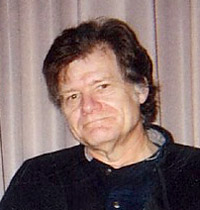
| Jacket 36 — Late 2008 | Jacket 36 Contents page | Jacket Homepage | Search Jacket |
The Internet address of this page is http://jacketmagazine.com/36/r-chace-rb-olson.shtml
Joel Chace
Cleaning The Mirror
reviewed by John Olson
Buffalo, New York: BlazeVOX [books], 2007. 226 pages. $16.00
This review is about 5 printed pages long. It is copyright © John Olson and Jacket magazine 2008.See our [»»] Copyright notice.
1
The phrase “cleaning the mirror” invites reflection. It is not an idle utterance. The mirror is a metaphor for consciousness in Chinese Buddhism. It reflects the world. The cleaner it is, the brighter it is. According to the poem by the fifth Zen patriarch, Shen-hsiu,
2
This body is the Bodhi-tree.
The mind is like a mirror bright;
Take heed to always keep it clean
And let not dust collect upon it.
(Suzuki 17)

paragraph 3
When the mind is “cleaned” of earthly distractions — envy, prejudice, resentfulness, delusion, misconception, etc. — it becomes enlightened to its own nature. This sounds simple enough, but how we might apply the mirror-metaphor to a book of poetry is more complex. Is each page to be conceived as a mirror? Are words hindrances, or reflections?
One’s first impression of Chace’s poetry is one of space: space between the lines, space between the words, space gulping the reader’s eyes in liquid relation. Space holds the words in a void of non-determined perimeter, altering the utilitarian function of words as flat contingencies of systematized representation and emphasizing their essential intercession between absence and presence, being and nothingness. The mirror suddenly seems non-existent, more in keeping with sixth Zen patriarch Hui-neng’s poem:
4
There is no Bodhi-tree,
Nor stand of mirror bright.
Since all is void,
Where can the dust alight?
(Suzuki 22)
5
“Paper World,” the first poem of the collection, is anecdotal. It concerns the arrival of the Sunday morning newspaper from the point of view of children. The paper is a “hefty bundle,” “the world in a packet.” [author’s italics] (13) The air crackles with the sound of paper as the edition comes undone and is held and read and maneuvered by the parents. The children on the floor are one land. The parents “entranced behind the travel guide, the book review, were another land (13).” Chace grows rapturous: “the spirit of joy, the rustling, the whispering, almost a voice singing,/ moved on the waters washing the two shores, joining the two lands (14).” As sheets of the paper get flung aside, “discarded, set free and drifting (14),” the children receive these “ecstasies” “as light falls suddenly on the face of water (15).” The paper becomes a bonding force. It assumes the affiliating power of breath. The focus shifts from the paper to its words: the words become embassies of transcendence. Something like Emerson’s Over-Soul is suggested at the end: “and in their listening the lives of the listeners go out to meet those/ words,/ and when the speaking is done, the lives, now joined, mingled, come/ back/ all into each one (16).”
6
Cleaning The Mirror is divided into nine sections. Each section is titled which suggests that the sections are arranged thematically, or stylistically, rather than chronologically.
7
Part III is titled o-d-e. It does not say to what. The answer to its exalted subject is in the poem itself, although a clue to the particulars of the poem is implied in the discrete spelling of ‘ode.’ We are invited to think of language as, perhaps, the subatomic particles holding the world together. This becomes evident when we turn the page: the words float in dreamy disseveration, detached, distinct, disengaged. There is far more space in evidence than words, which appear to hover in constellation, unattached in their combinations, unlimited in their possibilities. The poem begins with the word ‘ode’ broken into its component phonemes, “ed o ed o ed,” (65) the letters peculiarly reversed.
8
In his poem Un Coup de dés, Mallarmé was among the first to dramatize the dynamics of space, forcing the reader to reconstruct the text as the words appeared to assume a two-dimensional materiality, bobbing and oscillating on the surface of the paper. Several observations on this subject by Virginia La Charite in her book The Dynamics of Space are pertinent to Chace as well: “Objectively, detachedly, and deliberately, Mallarmé scrutinizes words as objects, he continually moves them around to form new patterns with which to dazzle the spectator (20),” and “Poetic manipulation of space determines the reading of the text, for it is the use of space as the element of design which determines the image: where the image begins, where it stops and returns (37).”
9
So what is o-d-e an ode to? The word ‘divine’ appears multiple times throughout the poem, as do the words and phrases ‘floating world,’ ‘viola,’ ‘snow,’ ‘mirror,’ and ‘mad with words.’ This is an extremely atmospheric poem in which space has an electric presence, charged as it is before, during, and after it has snowed. We feel the energy of something intangible giving life and vigor to the words, unlinked and discrete as they are in this work. The relationship between the sound, shape, and meaning of words is atomized into tumbling components. We hear cabs “shuh shuh shuh” outside in the “rainstreets.” We are witness to the becoming of signs. Signs as they drift through the air, whirling and delicate and silly. Signs as flakes as they fall to the ground to become blankets of communal white or the slush of slippery streets.
10
Parts VI and VII (titled Translations From After First Series and Translations From After Second Series) are less concerned with space and the arrangement of words on the page than the primordial loam of root and phoneme. The poem in these sections urge vocalization. “Forgetfulness twines our breachings,” begins the final stanza in the poem on page 151, “Farewells, surf wwwwwww, secrestions/ have laced duralnesses, roomy, waitless,/ precisely in the riddle’s dots.” Neologisms such as ‘secrestions’ and ‘duralnesses’ are legion. It is possible, such as the puns and neologisms of Finnegans Wake, to unravel three or four words out of a single word. ‘Secrestion,’ for example, yields ‘secretion,’ ‘crest,’ ‘suction,’ and perhaps ‘escutcheon.’ ‘Duralnesses’ yields ‘durable,’ ‘rural,’ ‘aural,’ and ‘duress.’ Strings of single syllables, such as ‘wwwwwww’ or ‘bbbbbbb’ are also common. How they might be pronounced is left to the imagination of the reader. What I imagine are sounds rattling like pebbles in a tin can, the huff and slush of surf splaying out in the sand. Spurts, growls, silences, and the hiss of punctured words.
11
Parts VIII and IX (titled faint gods and terrible thread) are baldly telegraphic. They have a rushed, hectic quality, as if each phrase and image were an éclat of heightened attention. Each begins with a period, a simple dot, and ends with a dot, not at the end of the word where it should be, but a few spaces to the right, isolated, enigmatic, grain-like. A tiny, semiotic speck. The arrangement of the words and punctuation on the page are a crucial part of its meaning, its display. Here, for instance, is “night shift,” on page 217:
12
. now that was a left-brained
arachnid / deluding destiny / avoiding
undercover narrative loud /
nasty styles have distressed
evaluators who’ve networked /
incorporated / if not recapitulated the
audible poem was superb / in fact
diamonded / fighting back / crypted / quite
marvelously lettered in fists we’ve
all suspected public display but
have kissed the prophet’s ring .
13
Chace uses disjunction to large effect here, heightening the sense of space and the highly fragmentary character of the phrases and words. The way the article ‘the’ hangs out in space is emblematic of Chace’s art. It extends from the line like a musical note spaced one octave apart in order to give a sense of delayed resolution. I find this effect echoed in the line “diamonded / fighting back / crypted / quite,” in which each word and phrase is endowed with a forceful solidity. What is most vividly evident in these works is the fierce attention devoted to the elements of language, its smallest yet most vital components. Chace has chosen to focus on clearcut units of signification rather than a broader narrative framework in order to replace the mirrors of reference with something cleaner and brighter: the perpetually irresolvable space between absence and presence.
Chace, Joel. Cleaning The Mirror. Buffalo, New York: BlazeVOX [books], 2007.
La Charite, Virginia. The Dynamics of Space: Mallarme’s Un Coup De Des Jamais N’Abolira Le Hasard. Lexington, KY: French Forum Publications, 1987.
Suzuki, D.T. The Zen Doctrine of No Mind. Edited by Christmas Humphreys. London: Rider Books, 1991.

John Olson
John Olson’s most recent publications include Blackscatter: New and Selected Poems (Black Widow Press, 2008) and Souls of Wind (Quale Press, 2008), a novel about the exploits of French poet Arthur Rimbaud in the American West of the 1880s in which he goes digging for Pleistocence fossils in New Mexico and meets Billy the Kid.